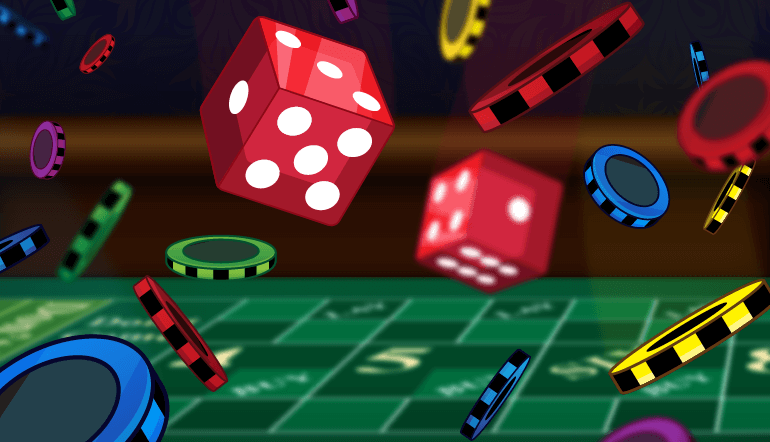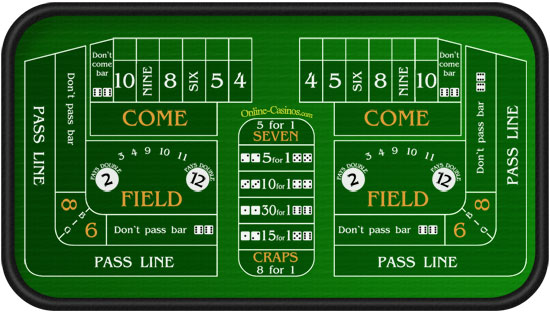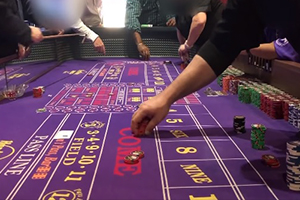Craps Rolling Techniques
- For those unfamiliar with the game: 2 dice are rolled and rolling a 7 or 11 is a win. 2, 3, or 12 is a loss. Any other number becomes the 'point' and the player rerolls until the point or a 7 is rolled. Matching the point is a victory. This time a 7 is a loss.
- The Rhythm Rolling Technique The essence of the technique is to give a false rattle of the dice using the Lock Grip,while holding specific numbers together using the Dice Settingtechnique, and to get the dice to spin like a wheel around one axis when travelling through the air to the backboard, and then not to let the dice.
How to Play Craps. Craps is a game where many bettors get to stake their chips on a roll of the dice. The table layout makes the game seem a little confusing at first, but the rules are easy to pick up with experience.
Big Fish Casino now includes a real-time social Craps game! Big Fish Casino is the first digital casino to offer synchronous play in a mobile Craps game, a feature many experienced digital casino players have been anticipating and the most requested game by Big Fish Casino players.
Whether you use this document as a reference when things get difficult or as a road map to get you from beginning to end, we’re pretty sure you’ll find what you’re looking for here.
We hope you find this information useful as you play your way through the game. Use the menu below to quickly jump to whatever stage of the game you need help with. Remember to visit the Big Fish Games Forums if you need more game help, or for technical trouble shooting on your iOS device, please see our FAQ.
Walkthrough Menu
Getting Started

- The game of Craps is centered on the outcome of rolling a pair of dice.
- Choose the Craps logo (A) in the lobby of the Big Fish Casino app, and then select the room of your choice (B). The minimum bet for each room is clearly stated (yellow) for each room.
- Players take turns rolling the dice. The person throwing the dice is called the ‘shooter.’ The shooter on the board is the person with the dice (C) next to their avatar.
- The color of the chip next to your avatar (D) will appear on the board once you’ve placed a bet.
- Each round has two phases: the Come Out Roll and the Point. When the puck on the table is ‘Off’ (E), it means that ‘no Point’ has been established.
- At the beginning of the round, players will place a bet on the Pass line (F) or the Don’t Pass line (G). The shooter will then roll the dice; this is called the Come Out Roll. If the Come Out Roll lands on 4, 5, 6, 8, 9, or 10, then a Point (the second phase) will be established and a Puck with the ‘On’ side (H) will appear on the table next to the number that was rolled.
- If the shooter rolls a 2, 3, or 12, then the round is over and you lose your bet on the Pass line, but win if you bet on the Don’t Pass line. If the Come Out Roll is a 7 or 11, this is called a ‘Natural Win’. Players on the Pass line win and the ones on the Don’t Pass line lose.
- If you do not want to bet on the Pass and Don’t Pass lines, you can make bets that don’t require you to wait for a new round to begin. You can read more about these types of bets in the sections below (Come/Don’t Come/Field/Proposition bets).
General Tips
- The odds on each bet are shown at the time you place your bet. If the odds state 30 to 1 (I), it means that if you bet $100 and win, you will earn $3, 000. If the odds are 1:1 (J) on a $100 bet and you win, you’ll earn $100. If you’re a winner, you’ll see a sign like this (K) pop-up; it breaks down your exact winnings for that round.
- You can bet on several places on the table at a time, you’re not limited to one type of bet per round.
- The checkmark next to the player’s avatar (L) symbolizes that the player pressed Ready (M).
- There are 4 stages to the dice animations (N) to represent how ‘Hot’ a shooter is. They go from nothing, to glowing, to sparks, to flames, to red flames. It takes: 2, 4, 8, and 16 rolls respectively. If you crap out, the dice effect is removed immediately and in most all cases the dice are passed to the next shooter. The effect is updated at the end of a roll. So, if you have the dice and you’ve already rolled once. The next time you roll, assuming you don’t crap out, after the dice finish animating, they will begin to glow.
Pass and Don’t Pass
Pass
- The Pass line (O) is for players who are betting with the shooter (on the shooter’s side). You’re betting that the shooter is going to make a pass.
- If the shooter rolls a 7 or 11 on the Come Out Roll (the first roll) everyone on the Pass line wins. If the Come Out Roll is 2, 3, or 12 (Craps), everyone on the Pass line loses.
- The point numbers on the table are: 4, 5, 6, 8, 9, and 10. If the shooter rolls one of the point numbers, the point will be established. For this example we’ll use the number 5, so let’s say that the shooter threw a 5 on their first roll. The puck with the ‘On’ side (P) will be placed on the table above the 5. The shooter must roll another 5 before they roll a 7 for everyone on the Pass line to win. If the player rolls a 7 before they roll the next 5, then everyone on the Pass line loses and the dice goes to the next shooter (clockwise) at the table.
- You can’t remove your Pass line bet after the shooter has a Point.
Don’t Pass
- The Don’t Pass line (Q) is the opposite of the Pass line. Players are betting for the shooter to lose; this is not usually a popular bet.
- When you bet on the Don’t Pass line, you are betting that the shooter will not win. You win on this line if the shooter rolls a 2 or a 3 on the first throw. You lose your bet on this line if the shooter throws a 7 or an 11 on the first roll.
- If the shooter rolls a 12, then it will result in a push.
- You can’t bet on the Don’t Pass line after the shooter has a Point.
Come and Don’t Come
Come
- When you place a bet on the Come line (R), your chip will go onto the next number that rolls. For example, if you place a chip on the Come line and the next number that rolls is a 9, your chip will automatically go from the Come line to the 9 (S). The chip will stay there until the player rolls a 7 or a 9.
- On the Come line you lose on a 2, 3, or 12, and win on a 7 or 11. Once you bet on the Come line and you also have a bet on the Pass line, you will lose if a 7 is rolled once the Point has been established. In this example, the Point established was the 9. Come bets lose on a winning 7.
Don’t Come

- On the Don’t Come line (T), you lose on a 7 or 11, win on a 2 or 3, and push on a 12.
- The Don’t Come bet can be made at any point in the game. Place your bet on the Don’t Come area to begin.
- The first roll after a Don’t Come bet has been placed, determines the point. You are betting that the 7 will be rolled before your point. In other words, you are wagering against the shooter rolling the Point number or tossing what is called a ‘Seven-out.’
Placing the Odds
- Pass Line odds: If a 4, 5, 6, 8, 9, or 10 is thrown on the Come Out Roll (i.e., if a Point is established), most casinos allow pass line players to take odds by placing up to some predetermined multiple of the Pass line bet, behind the Pass line. This additional bet wins if the Point is rolled again before a 7 is rolled (the Point is made) and pays at the true odds.
- Don’t Pass odds: If a player is playing Don’t Pass instead of Pass, they may also lay odds, meaning they are betting that a 7 comes before the Point is rolled. Like the Pass Line, these bets are paid at true odds.
- Come and Don’t Come Odds: Odds bets can be made on the Come and Don’t Come bets as well and follows the same rules as the Pass and Don’t Pass odds.
Place, Buy, and Lay Bets
Place Bets
- Place bets (X) can be made on the 4, 5, 6, 8, 9, and 10. When you make a Place bet, you are betting that a particular number will be rolled before the 7 is rolled.
- These bets are considered working bets, and will continue to be paid out each time a shooter rolls the place Point number.
- Place bets are NOT working on the Come Out Roll. You can also remove, increase, or reduce Place bets at any time (unlike Come bets).
Buy Bets

- Buy bets (Y) function in the same way as place bets with one exception. Buy bets are paid at true odds, but a 5% commission is charged on the amount of the bet. Like Place bets, Buy bets are considered working bets, and will continue to be paid out each time a shooter rolls the Buy point number.
- Buy bets are NOT working on the Come Out Roll and you can also remove, increase, or reduce Buy bets at any time (unlike Come bets).
Lay Bets
- If you want to bet against a number coming up, you can lay the odds and hope a seven rolls and you win before the number rolls and you lose. Again, you will pay a 5 percent commission every time you win.
- Lay bets (Z) are NOT working on the Come Out Roll and you can also remove, increase, or reduce Lay bets at any time (unlike Come bets).
One-Roll Bets or Proposition Bets
- The Proposition area (one-roll bets) is the section of the table in which you will be betting on one specific roll of the dice. The odds of winning on this area of the table vary; check each combination to view the odds. In order to win in this area, the numbers have to appear exactly as shown, no other combinations will win. You can view all combinations here (A).
- The Field (B) is the section for one-roll bets in which you bet that one of seven numbers will occur (2, 3, 4, 9, 10, 11, 12) on the next roll of the dice. You don’t have to place your bet on any specific number, just place it on the Field. If one of those numbers comes up, you win, if it doesn’t, you lose.
- If you bet on the area marked Any Craps (C), you’ll win if the rolled number is 2, 3, or 12.
- Seven (D): you win in this section if the next number rolled is any combination of the dice that adds up to seven (4 and 3, 2 and 5, 6 and 1).
- C and E (E) on the table stand for Craps and Eleven (Yo). This is what’s called a combination bet. You are betting that the shooter will roll Any Craps (2, 3, 12) and 11. If any of those numbers come out, you will win.

Multi-Roll Bets
Hard Way Bets
Craps Rolling Techniques

- A hard way bet (F) is when both dice turn up with the same number. The numbers to choose from are 4, 6, 8 or 10. The player loses if the shooter rolls a 7 or any combination of the chosen number that isn’t a double.
- If you place a bet on hard 6, you lose if the dice show 4 and 2 or 5 and 1. You will also lose if the dice show any combination that makes 7. The only way you win is if the dice show 3 and 3.
Big 6 and Big 8 Bets
Craps Rolling Techniques
- The Big 6 bet (G) is a wager that the 6 will be rolled before the 7 will. If any other number is rolled it does not affect the result and the dice are rolled again.
- Consequently, the Big 8 bet (H) is a wager that the 8 will be rolled before the 7 is.
- These two bets could be made at any stage of the game, including on the Come Out Roll.
Craps Lingo
Craps Dice Rolling Techniques
- It can be confusing when players are throwing out terms you may not be familiar with. Please read below to see what some of the most common terms mean.
- Select the box (A) on the top for your keyboard to appear. Type a message for your fellow players and hit Send.
- Ace/Deuce: 1 and a 2.
- Any Craps: A bet that the next roll will be 2, 3, or 12.
- Any Seven: A bet that the next roll will be 7.
- Ballerina special: Two twos.
- Bones/Cubes/Boxes: Dice.
- Boxcars/Midnight: Two 6s.
- Center Field: 9.
- Cold Dice: used to describe the table when no one is making their point.
- Craps: 2, 3, or 12.
- Hot Dice or Hot Table: when players are winning or a player is rolling a lot of numbers.
- Jesse James: 9.
- Jimmy Hicks: 6.
- Lay Bet: betting that a 7 will be rolled before the Point.
- Little Joe, or Little Joe from Kokomo: 4, rolled as 1 and a 3.
- Natural Win: the Come Out Roll is 7 or 11.
- Point: the number that appears on the Come Out Roll.
- Puppy Paws: Two 5s or commonly known as Hard 10 or 10, the hard way.
- Right Bettor: A player with a bet on the Pass line.
- Seven-out: shooter rolls a 7 on a roll after the Come Out Roll.
- Skate and Donate: 8.
- Skinny Dugan: A loser 7.
- Snake Eyes/Rat’s Eyes: Two 1s.
- Wrong Bettor: A player betting against the shooter.
- Yo or Yo-leven, C and C-craps: 11.